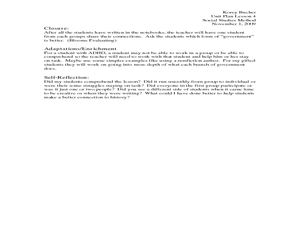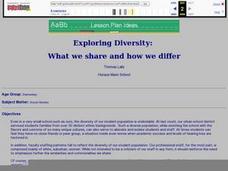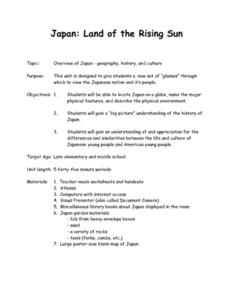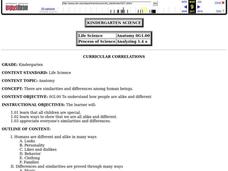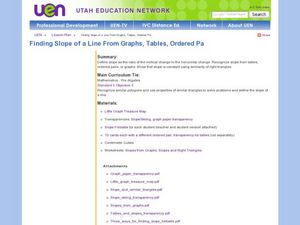Curated OER
Types of Branches
Fourth graders study the three branches of government. In this politics lesson, 4th graders list the three branches of government, understanding what each branch does, and compare and contrast how government is run with how the...
Curated OER
Games Children Play: Then and Now
Second graders examine primary documents to discover similarities and differences in life today and life before. In this toys then and now lesson, 2nd graders complete a graphic organizer to show how things have changed or stayed...
Curated OER
Mitosis and Meiosis Comparison
This t-chart provides a graphic organizer for pupils to list similarities and differences between the two types of cell division. There are no instructions on the handout, so more concrete thinkers may need a little guidance.
Curated OER
Comparing Authors (Venn Diagram)
Need a template for a Venn diagram? This one is designed to show the similarities and differences between two authors. Although no explanations are included, the graphic is self-evident.
Curated OER
Same or Different?
For this same/different worksheet, students look at 2 very similar pictures and look for a total of 8 things that make them different from one another.
Curated OER
Sharing with Others (Private/Religious)
Students appreciate uniqueness and differences by comparing and contrasting fruit. In this differences lesson, students study fruits and analyze for similarities and differences. Students sort the fruit into five categories. Students...
Curated OER
Patriotic Differences
In this patriotic symbols worksheet, students analyze 4 rows of American symbols, each with three similar pictures. Students circle the one that is different in each row.
Curated OER
Find the Odd One Out
In this find the odd one out activity, students click on the odd one that does not fit the characteristics of the other objects, answers are given online.
Curated OER
Recognizing How Another Culture Differs From One's Own
Students determine what it means to be on time. In this cultural comparisons instructional activity, students compare the notion of punctuality between the United States and Guinea. Students read "Being on Time," by Kimberly Ross and...
Curated OER
Exploring Diversity: What We Share and How We Differ
Students discuss the amount of diversity at their school. They examine a culture other than their own and share it with their classmates. They discuss the importance of diversity to end the instructional activity.
Curated OER
Finding Things That Are the Same
In this classifying worksheet, students examine 5 rows of animal clip art pictures. They circle the two animals in each row that are the same.
Curated OER
Finding Animals That Are the Same
In this classifying instructional activity, students circle the picture of an animal in each of 6 rows that matches the animal in the box at the beginning of each row. They see realistic clip art pictures of dogs, fish, moths, horses,...
Mrs. Glosser's Math Goodies
Perimeter & Area Worksheet 1
Test your mathematicians' skills with this full page of area and perimeter problems. Find the area and perimeter of different shapes including squares, parallelograms, trapezoids, and octagons. The formulas are not provided, so this...
Mrs. Glosser's Math Goodies
Perimeter & Area Worksheet 2
Alternate between area and perimeter with this worksheet, practicing both concepts with different shapes. Problems include examples with parallelograms, octagons, squares, rectangles, and trapezoids. The formulas are not provided,...
Mrs. Glosser's Math Goodies
Perimeter & Area Worksheet 3
There are many different polygons, so give your learners a worksheet that practices area and perimeter on the various shapes. This full-page worksheet includes problems with hexagons, trapezoids, squares, parallelograms, and rectangles....
Oleh Yudin
iCrosss
Did you know that a soccer ball is very similar to a truncated icosahedron? Both have 32 faces, but while a truncated icosahedron is made up solely of flat hexagons, a traditional soccer ball has 12 pentagons and 20 hexagons, each curved...
Teach-nology
Irregular Plural Nouns
Learners are asked to form the plurals of the five different types of irregular plural nouns listed on this worksheet.
Howard Hughes Medical Institute
Using DNA to Explore Lizard Phylogeny
In a fun and interactive two-day lesson, learners sort anole lizard pictures by appearance. Next, they watch a video about the anoles and re-sort based on the information in the video. In addition to physical characteristics, budding...
Curated OER
Japan: Land of the Rising Sun
Students locate Japan on a globe, name the major physical features, and describe the physical environment. They survey the differences and similarities between the life and culture of Japanese young people and American young people.
Yummy Math
Glowing Rectangles?
Middle school math masters use ratios to determine the missing dimensions of various HD television screens. They also compare different dimensions of screens and determine whether or not they fit the same ratio. They perform similar...
Curated OER
Anatomy
Students explore the similarities and differences in human beings. They consider that all students are special, and appreciate everyone's similarities and differences.
Curated OER
Solar Kit Lesson #3 Parts of a Solar Panel - Part I
A solar cell is similar to a rechargeable battery in many ways. Science lab groups connect each in a series circuit to run a mini motor and then compare and contrast them by answering questions and completing a Venn diagram. This is an...
Utah Education Network (UEN)
Finding Slope of a Line from Graphs, Tables, and Ordered Pairs
Middle schoolers explore the concept of slope in numerous ways and start to look at simple linear equations. They describe the slope in a variety of ways such as the steepness of a line, developing a ratio, using graphs, using similar...
American Chemical Society
Powder Particulars
By both demonstration and hands-on investigation, physical science fanatics come to know that some materials react when they come together. Adding vinegar to both baking soda and to baking powder, the difference between the two is clear....
